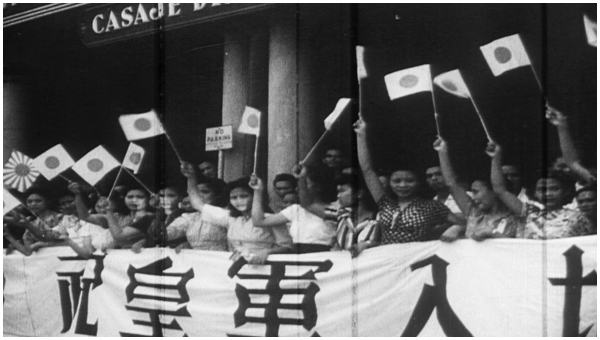菲奧娜‧阿蒙森 / 紐西蘭 / 1973年生,現於紐西蘭奧克蘭生活及工作
提姆‧柯博利 / 加拿大 / 1971年生於加拿大蒙特婁,現於紐西蘭威靈頓生活及工作 |
|
Fiona AMUNDSEN / New Zealand / 1973 born in Auckland, New Zealand, now living and working in Auckland, New Zealand
Tim CORBALLIS / Canada / 1971 born in Montreal, Canada, now living and working in Wellington, New Zealand |
| 〈機械之風〉是菲奧娜‧阿蒙森近來從攝影作為其藝術實踐之脈絡,前進到動態影像的範疇之中的嘗試。〈機械之風〉使用了散文電影的詩意框架,日本戰時的宣傳片段搭配上提姆‧柯博利口白,與阿蒙森所拍攝的昭南神社遺跡的長鏡頭畫面相互交織,底片膠卷的質感與數位電影攝影術的流暢,佐以柯博利朗誦日本馬克思主義哲學家戶坂潤的文字所形成的辯證性蒙太奇,切開了地理政治之疆界與歷史分期。在日本帝國軍佔領新加坡時期,澳洲與英國的戰俘建造了昭南神社,此神社在1942年完工,1945年在佔領結束後被摧毀;昭南神社作為阿蒙森整個作品的美學語韻,將她的攝影意識與散文電影細緻的接合,昭南神社的遺址位於新加坡麥里芝蓄水池(MacRitchie Reservoir)的密林中,對於阿蒙森而言,神社本身體現的是資本軍國主義與發展帝國主義之間詭譎的重疊,作為前帝國的日本與以軟性極權主義為治理手段的新加坡,前者的過去與後者的現在,卻映照出存在於現在之中的過去,因此,可以將〈機械之風〉視為回應主流歷史敘事中,那股驅動製造影像的裝置乃至工具導向的認識論的慾望。 |
Machine Wind (made in collaboration with writer Tim CORBALLIS) represents one of Fiona AMUNDSEN recent adventures into the terrain of moving image from the artistic trajectory of photographic practices. Machine Wind takes on the poetic frame of essay film, weaving together wartime Japanese archival propaganda footage with long static present-day shots of Syonan Jinja as well as Tim CORBALLIS’s voice-over. The textures of film reels, the smoothness of digital cinematography and CORBALLIS’s reflection on the Japanese Marxist philosopher Jun TOSAKA form a dialectic montage, which cuts through the geopolitical boundaries and historical periodization. Syonan Jinja, a shinto shrine built in 1942 by Australian and British prisoners of war during the Japanese Imperial Army’s occupation of Singapore, and destroyed in 1945 at the end of the occupation, operates as an aesthetic utterance that articulates AMUNDSEN’s photographic awareness into an essayistic film. For AMUNDSEN, the ruin of the Syonan Jinja, located deep in the MacRitchie Reservoir jungle, embodies the uncanny overlap of capitalist militarism and developmental nationalism, which is shared by the previous Japanese imperialist regimes, as well as and the present Singaporean soft authoritative governance. Machine Wind can be considered as a proposal for re-examining the predominant historiography, motivated by the desire of both the pictorial apparatus for image-making and the machinery-driven epistemologies. |

